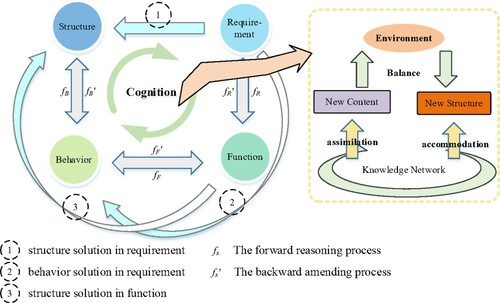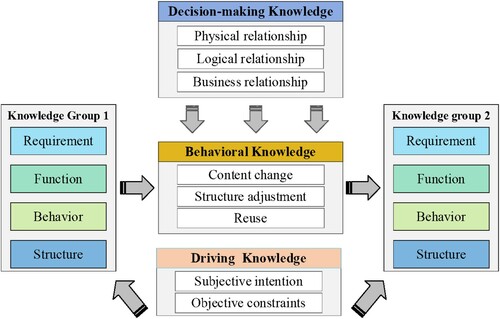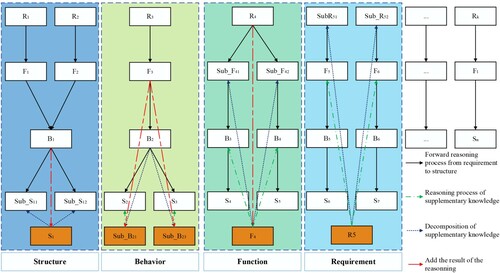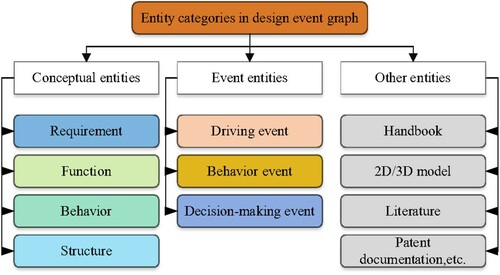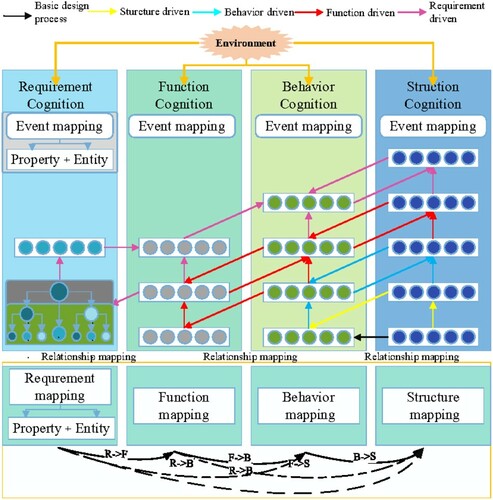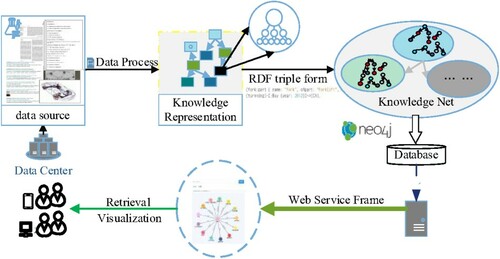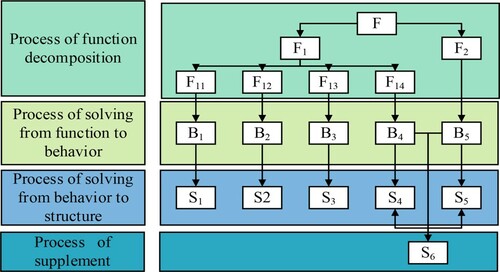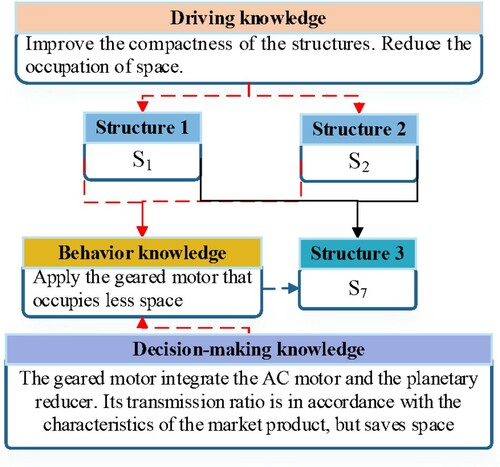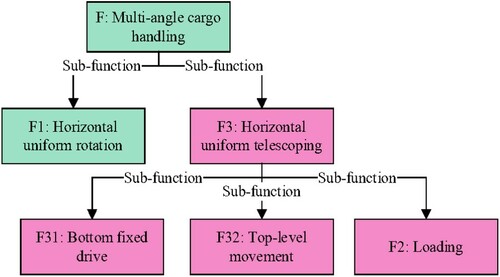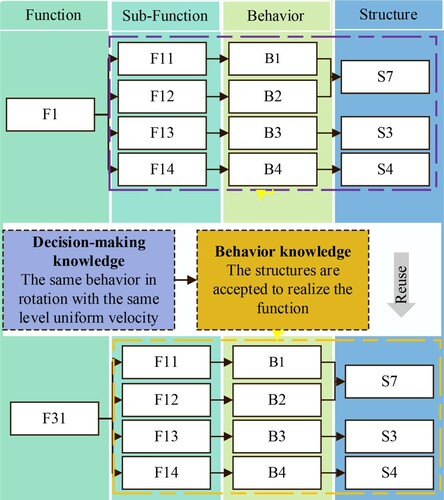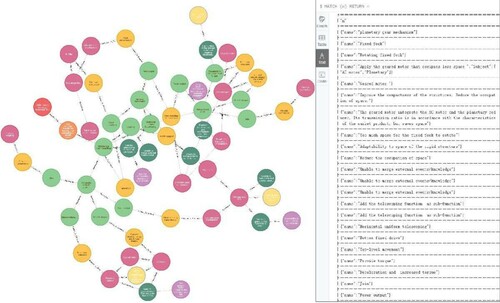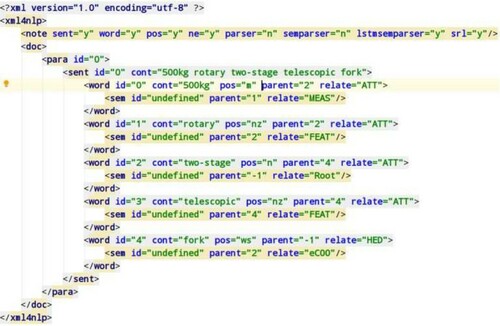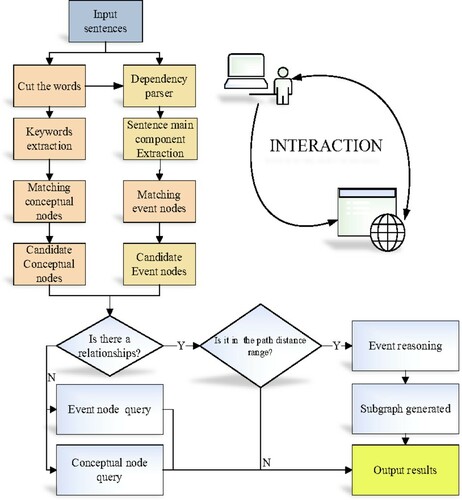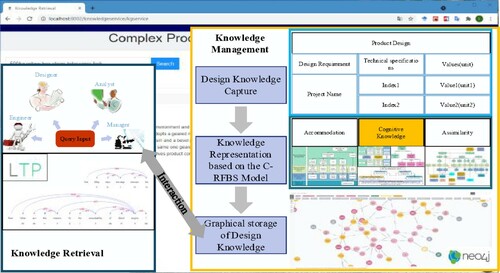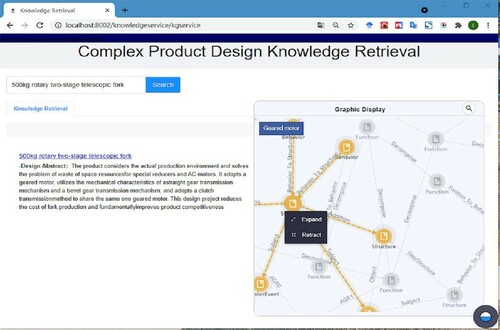 ?Mathematical formulae have been encoded as MathML and are displayed in this HTML version using MathJax in order to improve their display. Uncheck the box to turn MathJax off. This feature requires Javascript. Click on a formula to zoom.
?Mathematical formulae have been encoded as MathML and are displayed in this HTML version using MathJax in order to improve their display. Uncheck the box to turn MathJax off. This feature requires Javascript. Click on a formula to zoom.Abstract
Effective and efficient provision and reuse of knowledge across a knowledge network in the global value chain still faces two challenges, namely the interpretability of model and the efficacy of construction. This research aims to address these challenges by proposing a novel representation model for design knowledge. First, a knowledge representation model based on the integration of the cognitive process theory and the Requirement-Function-Behavior-Structure model (C-RFBS model) is proposed to incorporate key elements from the cognitive process of designers to capture the rationale of deliberation and the context of decision-making, which the knowledge records created become more interpretable. Second, knowledge graph is employed to improve the productivity of knowledge records creation, storage and exploration. On this basis, we describe the creation of knowledge records using the C-RFBS model as well as the computational framework and methods for storing knowledge using knowledge graph. The proposed model and methods are implemented in a knowledge retrieval system on which we have conducted a fork design case study to evaluate and demonstrate the models and methods. As shown in the evaluation, the proposed model can effectively support knowledge elicitation and achieved improved performance in terms of knowledge retrieval through incorporating knowledge graph.
Introduction
The global value chain (GVC) is a huge network covering the whole product life cycle, and its greatest value comes from the internal and external knowledge of the collaborative enterprises (Kano, Citation2018). Modern product design entails the collaboration between entities across the GVC to create more added values. The core of this collaboration is the sharing and reuse of design knowledge, which has become a hot topic with the rapid development of Artificial intelligence (AI) technologies. Apart from supporting collaboration, the reuse of design knowledge is also important to new product development and innovation. Previous studies have shown that 90% of all industrial designs are variant design in nature, and as much as 70% of design knowledge can be obtained from previous design solutions in redesign processes (Zhang, Zhou, et al., Citation2017). Nevertheless, only about 28% of design knowledge is reused throughout the product life cycle (Ettlie & Kubarek, Citation2008). The knowledge network has become a means of knowledge management, and the related studies mainly focus on the network structure, mode and evaluation method in specific fields (Liu & He, Citation2017). To bridge the gap, it is necessary to build a professional knowledge network for efficient product design and development. As the internal abstraction of knowledge network, knowledge representation model endows knowledge network with the ability to solve practical problems (Yin, Citation2016), such as providing data support for experienced designers, and also supplying design decision-making knowledge and knowledge-driven description that improves the interpretability of knowledge for inexperienced designers. Therefore, a knowledge representation model is the foundation for a global, dynamic and expandable enterprise design knowledge network. As the carrier of knowledge reuse (Zhang, Sun, et al., Citation2017), knowledge representation models need to organize more elements of design knowledge (Ma et al., Citation2013). However, the complexity and iteration of the product design and the multi-sources and heterogeneity of design knowledge make it very difficult for effective knowledge diffusion and reuse (Chandrasegaran et al., Citation2013), and as such, there is an urgent need to design an extendible and interpretable knowledge representation model.
The cognitive process theory suggests that one constantly adapts to the external environment to understand and recognize the world (Dodonov & Dodonova, Citation2011). Inspired by the findings of this theory, we develop a Requirement-Function-Behavior-Structure knowledge representation model based on the cognitive process (i.e. the C-RFBS model) in this paper to underpin the building of a knowledge network. The information systems using this model can capture explicit knowledge (e.g. standard manuals, CAD models, process protocols, draft, simulation data, patent, rules, etc.) and tacit knowledge (e.g. designers’ inspiration and experience, etc.) generated in a design in response to external environment stimulation. Specifically, the cognitive process will identify the relationships between knowledge elements, both explicit and tacit, and the external environment. Additionally, the cognitive process knowledge is also introduced into the model to architect correlations between new and old knowledge. Through these ideas, it can provide data support and design ideas for designers with varied levels of information granularity.
Besides the model, advanced retrieval methods also hold the key to knowledge service during the design process. Knowledge service involves two main requirements, namely the computational operations by computers and the reasoning process of designers (Chua et al., Citation2012). The multifaceted characteristic of design knowledge makes it difficult to be stored and reused. It is estimated that designers spend about 20% of their working time searching for and receiving information (Baxter et al., Citation2007) – this then raises the need of developing a new technology for supporting efficient storage and retrieval of design knowledge. Knowledge graph (KG), empowered by the most recent database and AI technologies, is regarded as a technology with great potential for large-scale application in industry. With a flexible data organization form, KG provides a set of systematic technical systems for heterogeneous knowledge management and reuse. As a special knowledge graph, Event Graph (EG) integrates event and conceptual knowledge to address the absoluteness of static knowledge in conceptual knowledge, building relationships between event entities, conceptual entities, and conceptual entities and event entities. Similar to human thinking, EG can express more complex semantic information (Deng et al., Citation2019). The information organization form of EG makes it suitable for storage and reuse of complex knowledge represented by the C-RFBS model. Therefore, based on the C-RFBS model, we adopt event graph to map design knowledge to conceptual knowledge and event knowledge in order to build a high-dimensional knowledge semantic network for knowledge storage and reuse. This work’s main contributions are summarized as follows:
Based on the cognitive process theory, a novel C-RFBS model is developed to improve the interpretability of knowledge by incorporating the cognitive process for providing a more contextual and interpretable description for newly added knowledge records. Moreover, this model can also represent multi-granularity knowledge in the form of a hierarchical structure to help transform personal knowledge into enterprise knowledge.
Knowledge graph is introduced into the product design domain to store and reuse knowledge. The graph representation framework of the C-RFBS model is proposed, and on this basis, the detailed method for storing design knowledge with multi-level information granularity in graph database is developed.
We develop a web service platform based on the event graph on which a set of knowledge retrieval case studies are conducted to evaluate the effectiveness and efficacy of the model and the methods proposed in this study.
The rest of this paper is organized as follows. In the next section, relevant work on knowledge representation models and knowledge graph is reviewed; the C-RFBS model is detailed and the method for building graph is explained; and the model and methods are evaluated in a prototype system through the development of some computational experiments. Discussion is given, and a conclusion is finally drawn along with the recommendations for further research.
Related work
Knowledge representation models
Knowledge representation models provide an organizational framework for knowledge in a specific domain and play a decisive role in the efficiency of knowledge capture, storage and reuse. The Function-Behavior-Structure (FBS) model (Gero, Citation1990) serves as an early knowledge representation model that can capture design knowledge during the reasoning process whereby structure is generated according to function. Considering the importance of function of design knowledge, many knowledge representation models embody complex knowledge based on function. For example, the Requirement-Function-Principle-Solution -Structure model (Zhu et al., Citation2015) explores the mapping relationships between function representations and structure parameters to capture design principle knowledge in design. The Function-Cell-Behavior-Structure model (Gu et al., Citation2012) takes a two-layer form: the principle layers and the physical layers. It specifically captures relationships between the knowledge of design principles and methods in the principle layer and the knowledge of physical behaviour and structure in the physical layers. Li et al. (Citation2010) proposed the functional micro-knowledge cell model to construct a knowledge representation consistent with the function layer, structure layer and functional ontology as the main parts. It captures detailed functional knowledge and the mapping knowledge of Function-to-Structure. To obtain more design knowledge to support redesign, Gascini et al. (Citation2010, Citation2013) analysed the definition of Need and Requirement in design projects, and highlighted the importance of need identification and requirement definition. In this model, needs and requirements are described as design goals and design constraints, respectively. In the Requirement-Function-Behavior -Structure model (Christophe et al., Citation2010), requirement analysis is regarded as a pivotal source of knowledge and knowledge representation is implemented using the SysML language. Additionally, semantic technology is also used as a tool for empowering knowledge representation. For instance, a multi-level Knowledge Representation Ontology model (Guo et al., Citation2015) is developed to express tacit knowledge in conceptual design, which makes explicitly the semantic information of functions and components in design activities. Qin et al. (Citation2017) investigated the capture of tacit knowledge throughout the design process, and proposed the Requirement-Function-Behavior-Evolution model to represent tacit knowledge using various elements relative to engineering know-what, know-how and know-why.
These design knowledge representation models essentially elaborate a structure for linking varied knowledge elements across different stages of the design process. However, due to a lack of components for embodying complex relationships and understanding knowledge, these models mainly provide historical data and experience support for experienced designers. In this study, a C-RFBS model is proposed, which can represent knowledge about the design object in terms of its requirement, function, behaviour, structure in the same means as the RFBS model. Moreover, it is aimed at solving the problem of what knowledge to organize, how it can be organized, and more importantly, how the cognitive process can help interpret. The cognitive process knowledge also interprets the structure and content of knowledge elements under the premise of achieving a uniform representation of design knowledge. Through capturing knowledge of the cognitive process of creation, deliberation, and decision, this knowledge can better serve inexperienced designers.
Knowledge graph applications
Knowledge representation models provide a structure for organizing knowledge elements. To support successful applications of design knowledge management, effective knowledge retrieval and reuse are also essential. As a new powerful technology, Knowledge graph (KG) integrates knowledge extraction, knowledge fusion (Bordes et al., Citation2013; Wang et al., Citation2014) knowledge reasoning (Chen et al., Citation2020), knowledge storage and reuse (Mathew, Citation2016) into a technical system. It is used to build a knowledge network through imitating the human thinking process and facilitating knowledge service using graphical storage. Since Google launched the knowledge graph project which was initially applied to improve results relevance (Yu et al., Citation2020), a considerable amount of work on KG has been conducted based on the data of WordNet, Wikidata and other open databases. For instance, based on the Wikidata dataset, (Citation2019) researched entity disambiguation of short text. Wu wt al. (Citation2020) presented a framework of knowledge graph construction, based on Baidu Baike, Hudong Baike and Chinese Wikipedia, to extract and link knowledge elements. Natural language process (NLP) makes it possible to automatically construct elements for knowledge graphs. KG has higher requirements on the quality of data, and thus has been successfully applied to areas such as biomedicine (Shen et al., Citation2019) and finance (Xue & Huang, Citation2017) with a large amount of structured data.
Although sufficient data has been generated due to the application of IT systems in industry, there is an apparent lack of knowledge samples. As such, efficient storage and reuse of knowledge have become the predominant goal of current knowledge graph applications in industry. Many researches have shown that graphical storage improves significantly the efficiency of knowledge storage and services. For instance, Percuku et al. (Citation2017) used the Neo4j database to store the measurement data of substation, which make up for the defects of memory resource waste and poor relational adaptability of relational database when the data structure is complex. In the field of petroleum exploration and development, research showed that Neo4j database can save more than 13% memory space and promote retrieval efficiency by more than 30 times compared to relational database (Gong et al., Citation2018). Knowledge reuse, such as knowledge retrieval, knowledge-assisted decision-making, knowledge reasoning and so on, realizes the interaction between human and data through IT system. For improving the effectiveness of redesign, knowledge reuse has been introduced into the design domain. Wang et al. (Citation2009, Citation2012) researched the retrieval methods on knowledge of design rationale for design knowledge reuse. Jin and Guo (Citation2010) developed a knowledge-reuse-based computer design system to support variant and improving design of complex mechanical products. Although there exist some researches on knowledge reuse based on the knowledge graph in the manufacturing domain such as manufacturing equipment information query (Yan et al., Citation2020) and processing technology knowledge reuse (Li et al., Citation2018), there is still a lack of work on building knowledge graph from complex design data and reports. Through the investigation of knowledge graph, we propose a novel mapping frame structure for knowledge representation model in this research to support effective and efficient construction of knowledge graph from design data.
A model for representing product design knowledge
The cognitive process in the creation of knowledge network
Piaget’s cognitive process theory interprets the subject’s cognitive process as an interactive iterative process of assimilation, accommodation and balance (Zhang, Citation2014). We regard the design knowledge network as an independent individual knowledge network with the ability to continuously integrate and update knowledge for redesign. As shown in Table , knowledge network has the following characteristics which are distinctive at different stages of the cognitive process. In order to construct the knowledge network, the knowledge representation model is developed, and the cognitive process of the design is explained.
Table 1. Cognitive characteristics of knowledge network.
The C-RFBS model
During the design process, customer requirements are transformed into detailed technical information by designers to allow physical realization of the product. Designers consider the characteristics of the expected product and the current market trend to analyse these requirements, and communicate with customers to confirm details about the key functions. In the traditional function-behavior-structure model of product, function decomposition and combination affect rationality of the behaviour and structure analysed and elaborated subsequently and behaviour also affects rationality of structure. Thus, as the main embodiment for the requirements and product characteristics, structure layer affects the entire design activities.
The C-RFBS model proposed in this work views design activities such as requirement mapping, function mapping, and behaviour mapping as a process whereby records in an existing knowledge network contextualize and adapt to the external environment. Changing of knowledge contents and structures is accompanied by the cognitive assimilation and accommodation, as shown in Figure .
In this paper, the conceptual design process consists of the forward reasoning process and the backward amending process, which relies upon the articulation of designers’ experience and knowledge. The cognition takes place during these processes and cognitive terms in the design process are shown in Table .
Table 2. Concepts and their interpretations during the cognitive process in design.
Cognitive process in design
Cognition is a process whereby external environmental information is captured, categorized and articulated. Knowledge can be captured in the process of problem solving from requirement to structure. Furthermore, tacit knowledge captured is externalized and relationships between decision-making knowledge, behaviour knowledge and driving knowledge are identified. In the meanwhile, the relationships between the internal and external knowledge units/groups are also constructed. Specifically, the C-RFBS model is focused on capturing the knowledge of product improvement, variation, and development, and the cognitive process (i.e. assimilation and accommodation) provides the foundation for building the local and global knowledge networks. An integrated knowledge network is then established to combine cases of success and cases of failure.
The cognitive process of multiple knowledge groups is shown in Figure in which these knowledge groups come from different design cases or design processes. And these knowledge groups must meet the following two conditions.
First, the internal conditions of the knowledge groups: the knowledge groups can be represented by one or more complete triples of knowledge to ensure their completeness.
(1)
(1) where Kg represents a knowledge group and ktn represents a knowledge triples. Second, the external conditions of the knowledge groups: there are one or more nodes in the Kgi {i = 1,2,.., n}that are directly related.
(2)
(2) where Kg1 and Kg2 represent two knowledge groups, respectively, and r represents one or more relationships between nodes of Kg1 and Kg2.
Among them, behaviour knowledge describes the behavioural measures (e.g. changes in structure, updating of content, etc.) taken by the existing knowledge network to adapt to the external environment, which also shows the status of knowledge unit/group and explains how new knowledge is generated. Decision-making knowledge describes the possible physical, logic and business relationships between new knowledge and old knowledge, and provides an interpretation for both the generation of new knowledge and the reuse of old knowledge. Driving knowledge translates external environment factors into understandable knowledge, and represents the driving force behind the generation of new knowledge in a knowledge network. Knowledge records derived from different design cases are independent of each other, and new knowledge records are embed in the existing knowledge network. The cognitive process establishes the reuse and step relationships between knowledge units/groups in the product design knowledge network. For facilitating the understanding of the cognitive process, some mathematical expressions are used to explain the assimilation and accommodation.
The assimilation process:
(3)
(3) where Kcurrent represents current knowledge unit/group; E is driving knowledge that can cause the content of current knowledge to change; and Knew represents new knowledge produced by changing the content of the current knowledge network.
The accommodation process:
(4)
(4)
(5)
(5) the accommodation process is a two-step process: the first step is shown in Equation (4) that describes that new knowledge K′ is generated through adjusting the structure of current knowledge network, and K′ is the newly generated knowledge that approximates Kcurrent in content. And the second step is shown in Equation (5) in the same means as Equation (3).
Cognitive process occurs at different mapping stages in the design. To further indicate that cognitive process is an interaction between design process functions and environmental variables, the knowledge representation process is divided into three basic processes: forward reasoning process, backward amending process and correlation construction. Assuming that the design process follows the sequential process of R-F-B-S, the expressions are then given as follows:
The forward reasoning process: from requirement to structure.
(6)
(6)
(7)
(7) in the above expressions, fx (including fR, fF, fB, f) is the reasoning function; P represents R, F, B, P−1 represents F, B,S correspondingly and Cassimilation represents the assimilation process in design including knowledge reuse and content update. Therefore, Equation (Equation6
(7)
(7) ) represents the reasoning process from P to P−1 and Equation (Equation7
(8)
(8) ) represents the reasoning process from R to S. During the process of forward reasoning, designers just change the relation path and knowledge content of a knowledge network without adjusting the network structure. In other words, the assimilation process only integrates external environment knowledge into current network, and constructs the step/reuse relationships between new and old knowledge.
The backward amending process: from structure to requirement.
(8)
(8)
(9)
(9) in the above expressions, fx′ (including fR′, fF′, fB′, f′) is the amending process function. P′ represents R′, F′, B′; Cassimilation is the assimilation process; and Caccommodation is the accommodation process. Therefore, Equation (Equation8
(9)
(9) ) represents the amending process from P−1 to P and Equation (Equation9
(10)
(10) ) represents the amending process from S to R. During the process of backward amending, designers receive the external information, and adjust the structure of the knowledge network to reduce the impact of driving knowledge accordingly.
The correlation construction process.
In order to support better knowledge reuse, the correlation formula is used to describe the direct relationship between new and old knowledge.
(10)
(10) where Knew is new content or new relationship, Kold represents the existing knowledge in the knowledge network.
is used to express the relationship to ensure that new knowledge is expressed in the form of triples. Based on the C-RFBS model, the correlation relation includes reuse, decomposition, mapping, explanatory and semantic relations, etc.
Based on the formulation of the forward reasoning and the backward amending processes, function and requirement may be adjusted by the cognitive process in the same means as behaviour and structure when environment changes. At the same time, differences in designers’ understanding will further lead to the dynamic process of knowledge network. Although requirement may provide partial solutions for function, behaviour, and structure in addition to the technical specifications and constraints, personal accumulation of knowledge and situation of historical knowledge reuse is critical to the decomposition of requirement, function, behaviour and structure. In particular, the decomposition granularity of requirement, function and behaviour decides whether expected structures could be obtained.
The multi-level structure model
Design is a decision-making process, and diversity of personal knowledge will affect the information granularity of knowledge records. Whether that desired knowledge could be matched in the knowledge network is an important criterion for the ability to quickly meet the requirement. Therefore, a knowledge network that meets multi-granularity knowledge query is more in line with the actual need.
One of the characteristics of the C-RFBS model is global extension, which exploits a multi-level structure to provide extended representation for reducing the differences in the decomposition of requirements, functions, behaviours and structures. The knowledge correlation between multiple sources of knowledge during cognitive process in which knowledge is restructured and revised. As shown in Figure , new knowledge is added to fasten the completion or correction of the structure, behaviour, function and requirement framework. For example, Sub_S11 and Sub_S22 are structure schemes of B1, and S1 is the integrated structure of Sub_S11 and Sub_S12. As a supplementary structure for B1, S1 provides a new selection for reasoning solution of B1 and adds keywords to be retrieved though B1 will decompose Sub_S11 and Sub_S12. On the contrary, Sub_B21 and Sub_B22 are the decomposed behaviour of behaviour B2, which refines the information granularity of knowledge so the knowledge can be easily accepted by other designers. As such, the multi-level structure minimizes the influence of personal knowledge on a knowledge network. And a more complex knowledge network is constructed to organize and manage knowledge of different granularities.
Knowledge graph mapping
The knowledge representation model is mainly used for human understanding, while knowledge reuse replies upon computer-understandable data structure. Event graph can easily realize contextualized retrieval through entity location and relation reasoning. Considering the complexity of the C-RFBS model, the heterogeneity of design knowledge, and the reuse needs of designers, we build an event graph usable in the design domain in which the entities can be classified into but not limited to the categories shown in Figure .
To facilitate knowledge computing, event nodes are described using noun and predicate phrases, which is represented formally in the following expression:
(11)
(11) in the above expression, S denotes the subject element; O is the object element; B describes the behaviour element; C is the condition element; and F represents feedback of environment. S and O are allowed to be none. The behaviour element describes the behaviours and statuses of a subject, the condition element describes the behavioural constraints or standards, and the feedback element means the feedback from external environment to a subject’s behaviour or status.
In the event graph, its nodes represent knowledge units including event and conceptual entities. Edges represent relationships between nodes, which corresponds to the business, logic and physical relationships in the model. Event knowledge mainly comes from the environment, behaviour and decision-making information in the cognitive process, and the event nodes contain driven event entities, behavioural event entities and decision-making event entities. There are four different kinds of relationships between the event entities, as listed in Table .
Table 3. Different categories of event relationships in the design event graph.
Specifically, event entities can storage complex knowledge to enrich conceptual knowledge. With Semantic Role Labeling (SRL), we build the semantic relation of event entities and conceptual ones. As shown in Figure , the ‘Parallel’ represents the parallel relationship between the event entities of ‘The sealing ring failed under high temperature and high pressure’ and ‘Material of the sealing ring aging and deterioration’. The AGR1 is the semantic relationship between the conceptual entity ‘Hydraulic cylinder’ and the event entity ‘The oil leakage of hydraulic cylinder is caused by collision test’.
Figure 5. A schema for representing the relationships between event entities and conceptual entities.
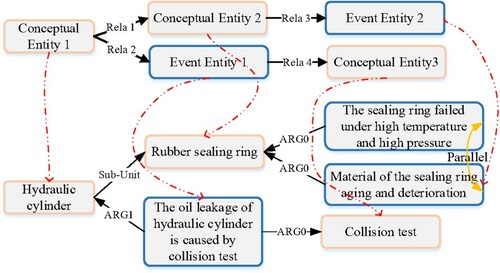
After representing the semantic relations, it is necessary for a graph construction task to address the confusion caused by the central nodes. A central node is passed by multiple paths, which usually contains key knowledge in the knowledge network. When there is a certain relationship between a parent node and a child node of the central node, unreasonable construction of relationship easily causes information loss or confusion in the process of subsequent knowledge retrieval. In order to maintain the importance of the central nodes and to prevent from paths’ confusion, we adopt the multi-dimensional paths to represent the relationships between nodes. As shown in Figure , the central node has three parent nodes and two child nodes. In the original knowledge network, there is a relationship between the central node and the child node 1 when parent node 1 is associated with the central node. Similarly, a relationship is built between central node and child node 2 when parent node 3 is associated with the central node. The resultant structure essentially involves three same central nodes for representing relationships with three parent nodes, respectively. This can eliminate the information loss and confusion mentioned above. In the improved knowledge network, the parent node 1 and 3 establish a relationship with the same central node. At the same time, the relationship between parent node 1 and child 1, and the relationship between parent node 3 and child node 2 are established to maintain the importance of the central node.
Finally, we build a representation framework of the event graph (as shown in Figure ) based on the C-RFBS model, schematic graph about building the relationships between event entities and conceptual entities, and the multi-dimensional path model for central nodes. Using this representation framework, a novel method is realized for building event graphs for effective knowledge reuse in the design domain.
Experiment
To evaluate the models and methods proposed in this work, we take the knowledge capture and reuse of a fork design case as the research object and develop a knowledge retrieval platform based on Python language and database Neo4j 3.5.1. The hardware in the development includes Windows 10 PC with a 2.82 GHz Intel Core i5 Processor and 8G Memory. Figure illustrates the system architecture of the platform developed using Web services technologies.
The RFBS process during the fork design
The proposed methods and models are explained using a fork design case. This design is required by a company (referred to as ‘the customer’ throughout this paper unless otherwise stated) to reduce the cost of adjustment and reconstruction of warehouses. An adaptive design is employed to meet the new requirements and knowledge reuse plays an important role. The customer proposes that ‘the fork can handle the loading and unloading of goods within 500 kg in the warehouse at an angular velocity of π rad/min’. Then, considering the market trend, and according to the terms and specifications, the requirements are initially formalized as shown in Table .
Then designers seek a design solution to achieve this customized design through market research and expert knowledge. During the process of forward reasoning, they map the requirements to the function ‘Multi-angle cargo handling’ that is divided into ‘horizontal uniform rotation’ and ‘loading’. As the customer gives a clear constraint on the angular velocity, these structures including AC motor, planetary reducer, flexible coupling, planetary gear mechanism and fixed fork are obtained. The obtained structures can meet customer’s expected requirement. Among these, the AC motor and planetary reducer can be flexibly matched to meet the required load moment and angular velocity. The FBS process is shown in Figure . The contents and symbol of the knowledge component of function, behaviour and structure are shown in Table .
Table 4. A requirement about 500 kg rotary fork.
Table 5. Contents and symbols of the Function, Behavior and Structure nodes.
Further, rotating fixed fork, as a new structure, is added to eliminate the influence of personal thinking. The rotating fixed fork involves all the behaviours of gear meshing transmission and matrix support. Besides, the fixed fork and planetary gear mechanism are the decomposition of the rotating fixed fork. The rotating fixed fork, as a supplement to available structure, is convenient for other designers to retrieve multi-granularity knowledge.
The cognitive process during the fork design
The structures discussed above have met the requirements. As such, the knowledge generated in the RFBS process can construct a local knowledge network to support knowledge reuse for meeting the design requirements of the 500 kg rotary fork. But when external factors act on the current knowledge network, the cognitive process is needed to update the network content and structure.
The assimilation process
In order to improve customer satisfaction, the design team expects to improve the fork to reduce the space occupation and production cost of fork as much as possible. The external factors then drive the current knowledge network to evolve. For designers, it is necessary to eliminate impacts on network through changing knowledge content or structure.
Geared motor has been widely applied as a power structure in the design field. Though its load torque and transmission ration of geared motor are relatively limited, its space occupation is reduced greatly, compared with the combination of planetary reducer and AC motor. Therefore, geared motor, as a better structure, replaces the AC motor and planetary reducer. The fuzzy factor that reducing space occupation, is transformed into driving knowledge embedded into the current knowledge network. At present, geared motor provides the behaviours of the AC motor and planetary reducer. AC motor and planetary reducer explain the new knowledge about geared motor. As shown in Figure , the assimilation process achieves the balance between the knowledge network and the external environment.
The accommodation process
The rotating fixed fork also occupies a large space. During the backward amending process from structure to behaviour, knowledge network unable to eliminate the space constrain by modifying the content and structure of the behaviour layer. Then the structure of the function layer is reconstructed through adding the function of horizontal uniform expansion as a sub-function of the multi-angle cargo handling, as well as through adjusting the function of loading as a sub-function of the top-level movement. The resultant structure is shown in Figure .
After reasoning from the sub-function ‘Bottom fixed drive’ to the corresponding behaviours, all behaviours are the same as the function of horizontal uniform rotation, and the same knowledge can be directly used. As shown in Figure , the reuse relationship between these two knowledge groups is built by the behaviour and decision-making knowledge.
Like the reasoning process from the function of horizontal uniform rotation to behaviours, the rack and pinion mechanism, roller guide rail mechanism and matrix base are obtained in the solution of the function of top-level movement. Similarly, the backward amending is carried out to verify that the structures can meet the requirement. As the structures supplement, a two-stage telescopic fork is similar to the above rotating fixed fork mentioned above. It further reduces the space required. Accommodation is completed and the current knowledge network is extended. Further, the motor of horizontal uniform rotation shares with bottom fixed drive to reduce the cost of a motor and a coupling. Until now, the structures have relieved the impact of cost constraint and space constraint. The entire accommodation process is shown in Figure .
Design knowledge storage and reuse
Based on expert knowledge, design knowledge organized is represented as a standard form of RDF triples. All the design knowledge is imported into the neo4j database in the form of CSV files. For files with the audios, videos, diagrams and 2D/3D models formats, the local addresses of the corresponding files are stored in neo4j for data processing. In this study, 30 design cases are collected as knowledge sources to build the knowledge base. The display of graphical data in neo4j is shown in Figure .
Based on the Flask Web Service Framework, we build a Web services platform with knowledge retrieval and display function. Further, this study uses Part-of-Speech (PoS) Tagging and Dependency Parsing technology for sentences processing using the Language Technology Platform (LTP) (Che et al., Citation2010). A scheme of LTP is shown in Figure .
In this study, we adopt the PoS tagging to get the nouns and verbs in the sentences given as inputs from users. Then, the verbs are identified as relationships or attributes while the nouns are identified as entities or attribute value. The verbs and nouns are used to assemble the triples of entities, relationships, attributes and values. The Dependency Parsing is applied to getting the main structure of dependency. According to the relationship such as VOB and SUB, sentence main components can be obtained in the form of subject-predicate-object, subject-predicate and predicate-object. These triples are matched to event nodes in the event graph when designers perform knowledge retrieval. After getting the keywords set and sentence main components set, candidate conceptual nodes set and candidate event nodes set can be obtained by keywords matching. If a conceptual node is related to an event node, return the sub-graph. Otherwise, query directly. In this study, the retrieval is aimed at implementing knowledge reuse, and the more detailed retrieval algorithm is illustrated in Figure .
Based on the C-RFBS model, knowledge captured from design projects is organized and stored as knowledge base of the knowledge retrieval platform that can provide multi-scenario knowledge retrieval online, and main operating logic of the platform is illustrated in Figure . The system receives the query sentence that is the ‘500 kg rotary two-stage telescopic fork’, then finds the knowledge nodes matched according to the retrieval flow shown in Figure . Next, the web page will display textual results and graphical results, as shown in Figure . Additionally, the function buttons of ‘Expand’ and ‘Retract’ can flexibly adjust the results retrieved, besides, designers can obtain relevant knowledge by the function buttons of ‘Expand’ which expands the knowledge path.
Discussion
In this study, a novel knowledge representation model which integrates the representation of knowledge captured during the process of cognition is proposed to transform individual knowledge to enterprise knowledge. Based on the C-RFBS model, knowledge graph is introduced to store and reuse design knowledge captured and develop the knowledge service platform. A fork case study is conducted to verify the practicality of the proposed model and methods. And innovation and limitations of the research work are discussed below.
Capture design knowledge
Personal experience can instruct how to use preview knowledge and promote to generate new knowledge to meet clients’ requirement. The cognitive process provides the interpretable description for relationships between knowledge (including knowledge of successful and failed cases, knowledge of initial and improving cases), which capture designers’ knowledge to instruct and redesign. This knowledge consisting of driving knowledge, behavioural knowledge and decision-making knowledge built designers’ thinking to provide inexperienced designer with prior knowledge in the early stage of design. In other words, the model is aimed at constructing the relationships between knowledge from different design cases or different design processes through the dynamic process of environment-assimilation-accommodation. Both direct/indirect relationships between the knowledge units/groups of different processes are built to facilitate knowledge sharing. Further, designers generally make decisions relying on their own experience and references at the time, which leads the knowledge accumulated to be complex and differentiated. Thus it is hard to build an enterprise knowledge network. For transforming personal knowledge into enterprise knowledge, it is essential to reduce the difference of knowledge record from different designers. In our proposed methodology, multi-granularity knowledge is treated equally to establish relationships with context while maintaining the uniqueness and diversity of knowledge. In summary, the C-RFBS model can interpret the updates of content and structure of knowledge network which make it easy for designers to understand the whole RFBS process. Based on the evaluation index for knowledge representation models proposed in (Qin et al., Citation2017), we have included a few elements such as the applicability of knowledge, the transformation and capture difficulty to compare the models listed in Table .
Table 6. Comparison of the C-RFBS model with several similar previous models.
As shown in the comparison, the C-RFBS model achieves certain advantages in capturing and organizing knowledge and goes beyond previous models by adding a process dimension to the ‘R’, ‘F’, ‘B’ and ‘S’ elements in a knowledge presentation model. To the best of the authors’ knowledge, there is little work on exploring the potential of the cognitive process for adding this dimension. The C-RFBS model aims to build a large knowledge network. However, when too many knowledge groups are added, the amount of relationships between knowledge nodes will be constructed sequentially, which may result in a decrease in the efficiency of knowledge creation. On the other hand, the cognitive knowledge network cannot judge the correctness of knowledge. Since the C-RFBS model can integrate the knowledge of failed cases, it is necessary to mark the knowledge of failed case. Besides, cognition is a continuous decentralization process, but it is difficult to achieve this goal in the process of establishing a knowledge network based on the C-RFBS model.
Application of knowledge graph in the design field
Knowledge graph is exploited for knowledge storage and reuse based on the C-RFBS model. Its triple form of (head)-[relation]-(tail) improves the capability of processing semantic queries. But in the event graph, the existence of the central nodes leads that preliminary triple form is not enough to represent exactly relationships between nodes. In this study, consider importance of central nodes, multi-dimensional paths are used to express and define the relationships between nodes without losing the relationships between the parent nodes and child nodes. And conceptual and event knowledge both is organized in which event nodes and their relationships contain plenty of semantics that will analyse and cut sentences from inputting and database. Therefore, the Semantic Analysis is adopted to query information through words, sentences and semantics layers to prevent the semantic constraint from losing.
Equipped with the event graph, a knowledge retrieval platform is developed. The platform provides designers with a basic knowledge retrieval service, allowing designers to access in heterogeneous time and space. However, similar to human cognitive process, there are design intention problems and cold start problems in the platform. Its performance is lower in the early stage of knowledge accumulation. With the continuous addition of knowledge elements, the knowledge network is gradually expanded and enriched. In this way, the platform can get better stability after it has started running. And actual retrieve and display form is highly dependent upon data quality.
Conclusions and future work
With the increasing of cost of human resource, enterprises hope to reuse efficiently design knowledge to train and instruct inexperienced designers for product design. Cognitive process theory enriches further knowledge network, which the relationships between old and new knowledge are constructed and interpretable knowledge is captured through the processes of assimilation and accommodation. Compared with existing representation models, the proposed model can capture and organize multi-source design knowledge for effective reuse. And the multi-level structure of the model solves the integration problem of multi-granularity knowledge to transform personal knowledge into enterprise knowledge. Based on the representation framework of the event graph and methods of dealing with relationship, the event graph is suitable for storing the heterogeneous design knowledge that has multi-dimensional relational paths. Finally, the knowledge retrieval platform developed provides a retrieval case of knowledge of fork design, which shown that the above model and method is effective for knowledge transfer and redesign.
The model and methods proposed depend on the expert knowledge, in the future, it is necessary to adopt the intelligent algorithm to process automatically the design data to construct the domain knowledge graph. In addition, the more detailed retrieval methods will be researched to further suit retrieval based on the knowledge graph in future work.
Disclosure statement
No potential conflict of interest was reported by the author(s).
Additional information
Funding
References
- Baxter, D., Gao, J., Case, K., Harding, J., Young, B., Cochrane, S., & Dani, S. (2007). An engineering design knowledge reuse methodology using process modelling. Research in Engineering Design, 18(1), 37–48. https://doi.org/https://doi.org/10.1007/s00163-007-0028-8
- Bordes, A., Usunier, N., Garcia-Duran, A., Weston, J., & Yakhnenko, O. (2013). Translating Embeddings for Modeling Multi-relational Data. 2013.
- Cascini, G., Fantoni, G., & Montagna, F. (2010). Reflections on the FBS model: Proposal for an extension to needs and requirements modeling. <Go to ISI>://WOS:000301582200066.
- Cascini, G., Fantoni, G., & Montagna, F. (2013). Situating needs and requirements in the FBS framework. Design Studies, 34(5), 636–662. https://doi.org/https://doi.org/10.1016/j.destud.2012.12.001
- Cetoli, A., Bragaglia, S., O’Harney, A. D., Sloan, M., & Akbari, M. (2019). A neural approach to entity linking on Wikidata. https://doi.org/https://doi.org/10.1007/978-3-030-15719-7_10.
- Chandrasegaran, S. K., Ramani, K., Sriram, R. D., Horvath, I., Bernard, A., Harik, R. F., & Gao, W. (2013). The evolution, challenges, and future of knowledge representation in product design systems. Computer-Aided Design, 45(2), 204–228. https://doi.org/https://doi.org/10.1016/j.cad.2012.08.006
- Che, W., Li, Z., & Liu, T. (2010). LTP: A Chinese language technology platform (Vol. 2). Coling 2010 Organizing Committee. https://www.aclweb.org/anthology/C10-3004
- Chen, X. J., Jia, S. B., & Xiang, Y. (2020). A review: Knowledge reasoning over knowledge graph. Expert Systems with Applications, 141, Article 112948. https://doi.org/https://doi.org/10.1016/j.eswa.2019.112948
- Christophe, F., Bernard, A., & Coatanea, E. (2010). RFBS: A model for knowledge representation of conceptual design. CIRP Annals, 59(1), 155–158. https://doi.org/https://doi.org/10.1016/j.cirp.2010.03.105
- Chua, C. E. H., Storey, V. C., & Chiang, R. H. (2012). Knowledge representation: A conceptual modeling approach. Journal of Database Management, 23(1), 1–30. https://doi.org/https://doi.org/10.4018/jdm.2012010101
- Deng, S. G. J., Rangwala, H., Ning, Y., & Assoc Comp, M. (2019). Learning dynamic context graphs for predicting social events. https://doi.org/https://doi.org/10.1145/3292500.3330919.
- Dodonov, Y. S., & Dodonova, Y. A. (2011). Basic processes of cognitive development: Missing component in Piaget’s theory. In D. E. Ongen, C. Hursen, M. Halat, & H. Boz (Eds.), 2nd World Conference on Psychology, Counselling and Guidance-2011 (Vol. 30). https://doi.org/https://doi.org/10.1016/j.sbspro.2011.10.260.
- Ettlie, J. E., & Kubarek, M. (2008). Design reuse in manufacturing and services. Journal of Product Innovation Management, 25(5), 457–472. https://doi.org/https://doi.org/10.1111/j.1540-5885.2008.00314.x
- Gero, J. (1990). Design prototypes: A knowledge representation schema for design. AI Magazine. Vol. 11, issue 4: pp. 26–36.
- Gong, F. M., Ma, Y. H., Gong, W. J., Li, X. R., Li, C. T., & Yuan, X. B. (2018). Neo4j graph database realizes efficient storage performance of oilfield ontology. Plos One, 13(11), Article e0207595. https://doi.org/https://doi.org/10.1371/journal.pone.0207595
- Gu, C.-C., Hu, J., Peng, Y.-H., & Li, S. (2012). FCBS model for functional knowledge representation in conceptual design. Journal of Engineering Design, 23(8), 577–596. https://doi.org/https://doi.org/10.1080/09544828.2011.629318
- Guo, Q., Tian, L., & Wu, Y. (2015). A multi-level knowledge representation ontology for conceptual design. In M. S. P. Babu & W. Z. Li (Eds.), Proceedings of 2015 6th IEEE International Conference on Software Engineering and Service Science (pp. 401–405). <Go to ISI>://WOS:000380587400091.
- Jin, W. D., & Guo, H. (2010). Study on variant design and improving technology of complex mechanical products based on knowledge reuse. In D. Zuo, H. Guo, H. L. Xu, C. Su, C. J. Liu, & W. Jin (Eds.), Frontier in functional manufacturing technologies (Vol. 136, pp. 216–220). https://doi.org/https://doi.org/10.4028/www.scientific.net/AMR.136.216.
- Kano, L. (2018). Global value chain governance: A relational perspective. Journal of International Business Studies, 49(6), 684–705. https://doi.org/https://doi.org/10.1057/s41267-017-0086-8
- Li, S., Hu, J., & Peng, Y.-H. (2010). Representation of functional micro-knowledge cell (FMKC) for conceptual design. Engineering Applications of Artificial Intelligence, 23(4), 569–585. https://doi.org/https://doi.org/10.1016/j.engappai.2009.11.008
- Li, X. L., Zhang, S. S., Huang, R., Huang, B., Xu, C. H., & Kuang, B. W. (2018). Structured modeling of heterogeneous CAM model based on process knowledge graph. International Journal of Advanced Manufacturing Technology, 96(9-12), 4173–4193. https://doi.org/https://doi.org/10.1007/s00170-018-1862-8
- Liu, B. F., & He, G. J. (2017). Research on the architecture of enterprise knowledge network construction. In N. Xin, K. ElHami, & Z. Kun (Eds.), Proceedings of the 2017 7th International Conference on Social Network, Communication and Education. Atlantis Press. (Vol. 82, pp. 775–779). <Go to ISI>://WOS:000416091500158.
- Ma, J., Hu, J., Zheng, K., & Peng, Y.-H. (2013). Knowledge-based functional conceptual design: Model, representation, and implementation. Concurrent Engineering, 21(2), 103–120. https://doi.org/https://doi.org/10.1177/1063293X13487358
- Mathew, A. B. (2016). Comparison of search techniques in social graph Neo4j. In V. Vijayakumar & V. Neelanarayanan (Eds.), Proceedings of the 3rd International Symposium on Big Data and Cloud Computing Challenges (Vol. 49, pp. 293–305). https://doi.org/https://doi.org/10.1007/978-3-319-30348-2_24.
- Percuku, A., Minkovska, D., & Stoyanova, L. (2017). Modeling and processing big data of power transmission grid substation using Neo4j. In E. Shakshuki (Ed.), 8th International Conference on Emerging Ubiquitous Systems and Pervasive Networks (Vol. 113, pp. 9–16). https://doi.org/https://doi.org/10.1016/j.procs.2017.08.276.
- Qin, H., Wang, H. W., & Johnson, A. L. (2017). A RFBSE model for capturing engineers’ useful knowledge and experience during the design process. Robotics and Computer-Integrated Manufacturing, 44, 30–43. https://doi.org/https://doi.org/10.1016/j.rcim.2016.08.004
- Shen, Y., Yuan, K. Q., Dai, J. C., Tang, B. Z., Yang, M., & Lei, K. (2019). KGDDS: A system for drug-drug similarity measure in therapeutic substitution based on knowledge graph curation. Journal of Medical Systems, 43(4), Article 92. https://doi.org/https://doi.org/10.1007/s10916-019-1182-z
- Wang, H., Johnson, A., & Bracewell, R. (2009). Supporting design rationale retrieval for design knowledge re-use.
- Wang, H. W., Johnson, A. L., & Bracewell, R. H. (2012). The retrieval of structured design rationale for the re-use of design knowledge with an integrated representation. Advanced Engineering Informatics, 26(2), 251–266. https://doi.org/https://doi.org/10.1016/j.aei.2012.02.003
- Wang, Z., Zhang, J. W., Feng, J. L., Chen, Z., & Aaai (2014). Knowledge Graph Embedding by Translating on Hyperplanes. <Go to ISI>://WOS:000485439701016.
- Wu, T. X., Wang, H. F., Li, C., Qi, G. L., Niu, X., Wang, M., Li, L., & Shi, C. M. (2020). Knowledge graph construction from multiple online encyclopedias. World Wide Web-Internet and Web Information Systems, 23(5), 2671–2698. https://doi.org/https://doi.org/10.1007/s11280-019-00719-4
- Xue, Y. R., & Huang, L. (2017). Research on Internet Financial Fraud Detection Based on Knowledge Graph. <Go to ISI>://WOS:000468556900145.
- Yan, H. H., Yang, J., & Wan, J. F. (2020). KnowIME: A system to construct a knowledge graph for Intelligent Manufacturing Equipment. Ieee Access, 8, 41805–41813. https://doi.org/https://doi.org/10.1109/ACCESS.2020.2977136
- Yin, W. S. (2016). Standard model of knowledge representation. Frontiers of Mechanical Engineering, 11(3), 275–288. https://doi.org/https://doi.org/10.1007/s11465-016-0372-3
- Yu, H. Z., Li, H. S., Mao, D. H., & Cai, Q. (2020). A domain knowledge graph construction method based on Wikipedia. Journal of Information Science, Article 0165551520932510. https://doi.org/https://doi.org/10.1177/0165551520932510.
- Zhang, C., Zhou, G. H., Lu, Q., & Chang, F. T. (2017). Graph-based knowledge reuse for supporting knowledge-driven decision-making in new product development. International Journal of Production Research, 55(23), 7187–7203. https://doi.org/https://doi.org/10.1080/00207543.2017.1351643
- Zhang, D. D., Sun, J., Gong, Q. H., & IEEE (2017). Research on process knowledge representation and reasoning decision method based on structural features. <Go to ISI>://WOS:000427816107188.
- Zhang, Z. Q. (2014). Assimilation, accommodation, and equilibration: A schema-based perspective on translation as process and as product. <Go to ISI>://WOS:000342183000004.
- Zhu, G.-N., Hu, J., Qi, J., Gu, C.-C., & Peng, Y.-H. (2015). Design knowledge representation as an integration of functional knowledge modelling and design structure matrix. In C. Weber, S. Husung, M. Cantamessa, G. Cascini, D. Marjanovic, & S. Venkataraman (Eds.), Iced 15, Vol 10: Design information and knowledge management. <Go to ISI>://WOS:000366313100033.

